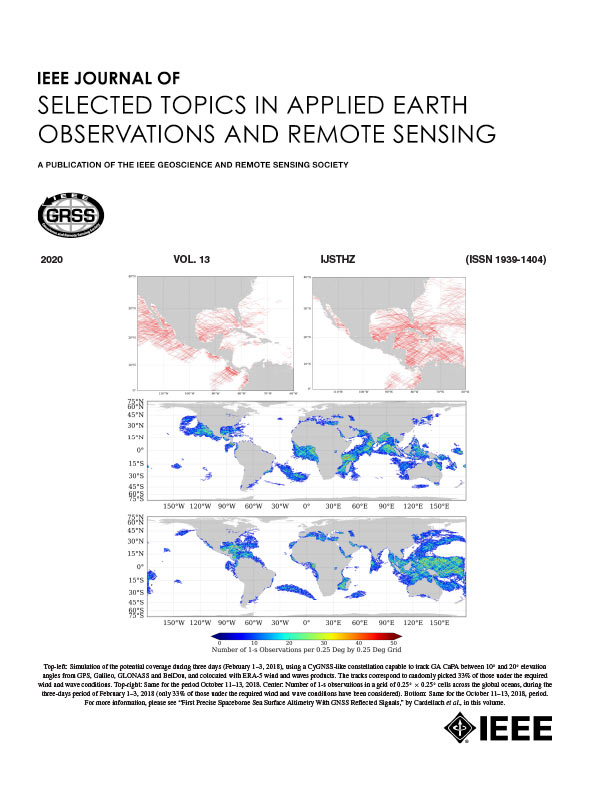LEO星座增强GNSS精确点定位对流层水平梯度建模方法比较
IF 4.7
2区 地球科学
Q1 ENGINEERING, ELECTRICAL & ELECTRONIC
IEEE Journal of Selected Topics in Applied Earth Observations and Remote Sensing
Pub Date : 2024-12-26
DOI:10.1109/JSTARS.2024.3523023
引用次数: 0
摘要
随着GNSS数据处理精度的提高,选择最优的非对称对流层延迟建模方法变得至关重要,特别是在恶劣天气事件期间和低地球轨道(LEO)星座增强型GNSS (LeGNSS)的发展。在本研究中,我们比较了几种对流层梯度模式在描述不对称对流层延迟方面的性能。利用稳定期和剧烈期的模拟数据,我们发现高阶水平梯度模型在实验中具有更高的精度。在LeGNSS高精度点定位方案中,二阶梯度模型表现最佳,对于水平分量、垂直分量和天顶总延迟(ZTD)参数,稳定期精度可达1.1/3.8/0.8 mm,剧烈期精度可达0.9/2.5/1.0 mm。对比分析了10°以下俯仰角的倾斜路径延迟精度,结果表明,定向模型更适合于低俯仰角观测,但由于引入过多的冗余参数,导致高俯仰角下的精度下降。在稳定期,LEO星座对水平分量、垂直分量和ZTD参数的精度提升最大,分别为32.9%、12.6%和27.9%;在剧烈期,LEO星座对水平分量、垂直分量和ZTD参数的精度提升最大,分别为26.5%、31.8%和34.9%。用高时间分辨率梯度参数代替传统的日梯度参数,可以显著提高极端天气事件中ZTD的精度。因此,本研究强调水平梯度模型的时空分辨率,以满足日益增长的GNSS/LeGNSS数据处理在恶劣天气事件中的需求。本文章由计算机程序翻译,如有差异,请以英文原文为准。
Comparison of Tropospheric Horizontal Gradients Modeling Methods in LEO Constellation Augmented GNSS Precise Point Positioning
With the improvement in GNSS data processing accuracies, the selection of optimal asymmetric troposphere delay modeling method becomes essential, especially during the period of severe weather events and with the development of low Earth orbit (LEO) constellation augmented GNSS (LeGNSS). In this research, we compare the performances of several troposphere gradient models in describing the asymmetrical troposphere delays. Using simulation data during the stable and severe periods, we find that the high-order horizontal gradient models exhibit higher accuracy in the experiments. In the LeGNSS precision point positioning solutions, the second-order gradient model performs optimally, with accuracies of up to 1.1/3.8/0.8 mm during the stable period and 0.9/2.5/1.0 mm during the severe period for the horizontal component, vertical component, and zenith total delay (ZTD) parameters. In comparison, the analysis of slant path delays accuracy for elevation below 10° shows that the directional model is more suitable for low elevation observations, but the introduction of too many redundant parameters leads to a decrease in the accuracy at high elevation angles. The LEO constellation can bring maximum 32.9%, 12.6%, and 27.9% accuracy improvement for the horizontal component, vertical component, and ZTD parameters during the stable period, while 26.5%, 31.8%, and 34.9% during the severe period. The estimation of high-temporal-resolution gradient parameters instead of traditional daily gradient parameters can significantly improve the accuracy of ZTD in the extreme weather events. Therefore, this research underscores the spatial and temporal resolution of horizontal gradient models, which meets the growing demand for GNSS/LeGNSS data processing during the severe weather events.
求助全文
通过发布文献求助,成功后即可免费获取论文全文。
去求助
来源期刊
CiteScore
9.30
自引率
10.90%
发文量
563
审稿时长
4.7 months
期刊介绍:
The IEEE Journal of Selected Topics in Applied Earth Observations and Remote Sensing addresses the growing field of applications in Earth observations and remote sensing, and also provides a venue for the rapidly expanding special issues that are being sponsored by the IEEE Geosciences and Remote Sensing Society. The journal draws upon the experience of the highly successful “IEEE Transactions on Geoscience and Remote Sensing” and provide a complementary medium for the wide range of topics in applied earth observations. The ‘Applications’ areas encompasses the societal benefit areas of the Global Earth Observations Systems of Systems (GEOSS) program. Through deliberations over two years, ministers from 50 countries agreed to identify nine areas where Earth observation could positively impact the quality of life and health of their respective countries. Some of these are areas not traditionally addressed in the IEEE context. These include biodiversity, health and climate. Yet it is the skill sets of IEEE members, in areas such as observations, communications, computers, signal processing, standards and ocean engineering, that form the technical underpinnings of GEOSS. Thus, the Journal attracts a broad range of interests that serves both present members in new ways and expands the IEEE visibility into new areas.

 求助内容:
求助内容: 应助结果提醒方式:
应助结果提醒方式:


